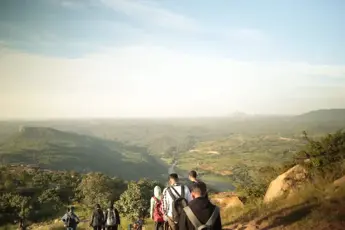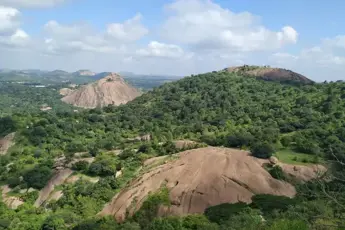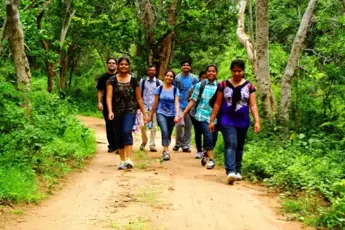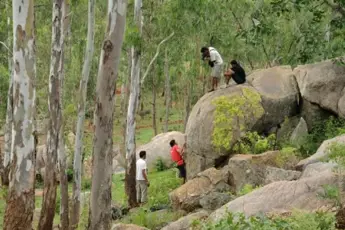Near Kalamandir(06:00 AM)
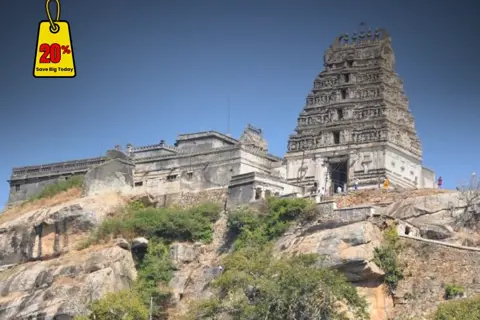

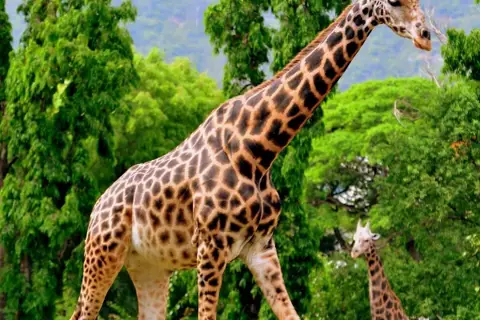
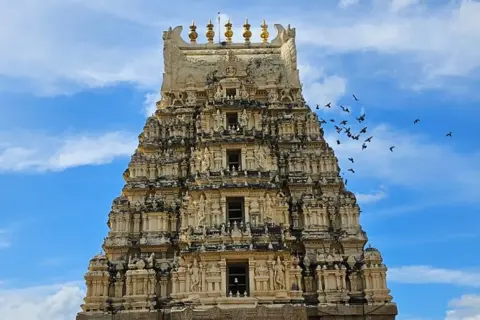
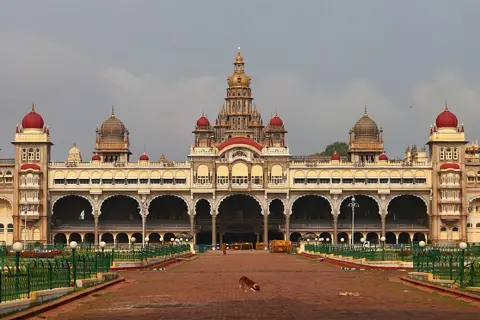

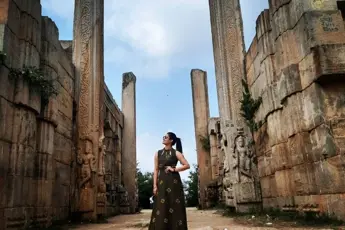

Images


Melukote and Mysore One Day Trip From Bangalore
Starting from INR 2427
Per Person
( Inclusive of all taxes )
Meal
Transport
Permit
Guide
Temple Visit
Meal
Transport
Permit
Guide
Temple Visit
Melukote Mysore Trip: Highlights
Visit Cheluvanarayana Swamy Temple in Melukote, a stunning example of Karnataka's rich architectural heritage.Enjoy a scenic and comfortable road trip from Bangalore to Melukote, covering picturesque landscapes.Explore Melukote Fort, offering breathtaking panoramic views of the town and its lush surrounding landscapes.Discover ancient temples in Melukote, each with a rich history, reflecting the town’s deep spiritual significance.Plan a one-day trip from Bangalore to Melukote for a perfect weekend getaway to explore culture and history.Travel conveniently by car or bus from Bangalore to Melukote, enjoying a smooth journey to your destination.Check Out: One Day Trip From Bangalore | Trekking Near Bangalore | Two Day Trip From Bangalore
Melukote Mysore Trip: Overview
Activity Location: Mandya, Karnataka.Start time: 06:00 AMEnd time: 08:00 PMDistance from Bangalore: 150 KmAbout Melukote Mysore One Day Trip:Embarking on a Melukote Mysore trip offers a captivating blend of historical significance, spiritual serenity, and picturesque landscapes, making it an ideal excursion for those near Mysore or even as a longer day out from Bangalore. Melukote, also known as Thirunarayanapuram, is a prominent religious centre steeped in the Sri Vaishnavite tradition, largely due to the 12-year stay of the revered saint Sri Ramanujacharya in the 12th century. This has imbued the town with a unique cultural identity, particularly among the Mandyam Iyengar community. A key highlight of any Melukote Mysore trip is the majestic Cheluvanarayana Swamy Temple, dedicated to Lord Vishnu. This ancient temple, with its impressive architecture that showcases Hoysala and Vijayanagara influences, is not only a significant pilgrimage site but also a treasure trove of historical and artistic marvels. The temple is renowned for its collection of crowns and jewels, most notably the diamond-studded Vairamudi crown, which adorns the deity during the annual Vairamudi festival, drawing lakhs of devotees. In essence, a Melukote Mysore one-day trip is more than just a visit to a temple town; it's an immersive experience into the rich history, vibrant culture, and scenic beauty of Karnataka. The spiritual aura, the architectural grandeur, and the tranquil environment make Melukote a truly rewarding destination for a day's exploration from Mysore.NOTE: For weekday departures, a group of 6 people is required.Trending Packages: Melukote Gommateshwara Trip | Adiyogi Lepaksi Trip | Art of Living Trip | Pyramid Valley Trip
Inclusion and Exclusion
This Package Includes:TransportationBreakfast (Veg)All tolls and permitsProfessional GuideCheluvanarayana Swamy Temple VisitRaya Gopura VisitRanganatha Swamy Temple visitZooPalaceChamundi TempleExcludes:LunchAll Entry TicketsAny Personal ExpensesAnything Not Mentioned includes
Tour Plan
Explore Mysore and Melukote
06:00 AM Pickup Starts From Bengaluru.08:00 AM Have breakfast on the way.11:00 AM Upon reaching Melukote, visit the famous Cheluvanarayana Swamy Temple.11:30 AM Exploring the Raya Gopura, the towering gateway to the temple. 12:00 PM After your visit to Melukote, head towards Chamundi Hill in Mysore.01:30 PM Upon arrival, you’ll visit the Chamundeshwari Temple, dedicated to the goddess Chamundeshwari.02:00 PM Have Lunch at the nearest Restaurant (Self-Sponsored).03:00 PM After lunch, head to the Mysore Zoo, also known as Sri Chamarajendra Park.05:00 PM Head Towards Mysore Palace.06:30 PM If time permits, head towards the Ranganathaswamy Temple in Srirangapatna.07:00 PM Head Back to Bangalore.08:30 After a day filled with sightseeing and exploration.
Package Variant Options
Melukote Mysore Trip With Transportation
Pickup Points
Bus Stop (06:30 AM)
Udupi - Garden Bus Stop, Opposite To A2B (06:40 AM)
Bus Stop (07:00 AM)
Gopalan Arcade, Mysore Road (07:30 AM)
Dropping Points
Bangalore
Things to Carry
BackpackRaincoat/PonchoWater bottlesEnergy foodPersonal medicationSports shoes or trekking shoes in good conditionTrack pants and a cotton T-shirtCamera (optional)
Starting from INR 2427
Per Person
( Inclusive of all taxes )
Enquiry Form
Why escape2explore
done Verified Google Reviews 5000+ Reviews on the google platform.done 500+ Tours and Activities We have activities across every category so that you never miss best things to do anywhere.done Customer Delight We are always able to support you so that you have a hassle free experience.
Reviews (162)
4.6
Out of 5.0
5
94
4
68
3
0
2
0
1
0

Jagadayu
Reviewed: Jan 23, 2025
5/5
looking for a peaceful day trip from Bangalore the Melkote one day trip with escape2explore is the one to choose They gave us excellent instructions on how to reach Melkote... Read More

Gajanan
Reviewed: Jan 23, 2025
5/5
Melkote one-day trip with escape2explore was a remarkable experience They provided clear instructions on how to reach Melkote from Bangalore by bus making the journey very convenient The Melkote Temple... Read More

Tanuja
Reviewed: Jan 23, 2025
5/5
Melkote one day trip enough Organized by escape2explore the journey was comfortable and easy with clear directions on how to reach Melkote from Bangalore by bus The Melkote Temple timings... Read More

Breshna
Reviewed: Jan 23, 2025
5/5
we had a fantastic day on our Melkote one-day trip. They provided us with easy instructions on how to reach Melkote from Bangalore by bus, which was a huge help... Read More

Aarohi
Reviewed: Jan 23, 2025
5/5
Exploring Melkote and Mysore in one day was made easy by escape2explore They shared valuable information on how to reach Melkote from Bangalore by bus which saved us time. Visiting... Read More
Related Packages
Frequently Asked Questions
Q1: What is included in the Melukote and Mysore one day trip package?
Our package includes round-trip transportation from Bangalore, sightseeing at Melukote and Mysore, entry fees (where applicable), a professional guide, and a well-planned itinerary to cover major attractions in one day.
Q2: What are the main attractions covered in this one day trip?
This trip covers Melukote's Cheluvanarayana Swamy Temple and scenic viewpoints, along with Mysore Palace, Chamundi Hills, and St. Philomena’s Church.
Q3: How far are Melukote and Mysore from Bangalore?
Melukote is approximately 140 km, and Mysore is about 145 km from Bangalore. The total round trip distance is around 300–320 km.
Q4: What time does the trip start and end?
The trip usually starts at 6:00 AM from Bangalore and ends around 9:00 PM, depending on traffic and sightseeing time.
Q5: Is breakfast or lunch provided in this package?
Meals are not included in the base package. However, we stop at popular local restaurants where travelers can buy breakfast and lunch.
Q6: Can I book the Melukote and Mysore trip for a private group?
Yes, private group bookings are available. You can also customize the itinerary slightly to suit your group’s interests.
Q7: Is the trip suitable for kids and senior citizens?
Absolutely. The trip is family-friendly, and we ensure adequate rest stops and manageable walking distances at sightseeing points.
Q8: What should I carry for the one-day trip?
Carry a valid ID, comfortable walking shoes, a water bottle, sunscreen, a hat/cap, and personal medication if needed.
Q9: What is the best time of year to take this trip?
The best time to visit Melukote and Mysore is between October and March when the weather is pleasant and ideal for sightseeing.
Q10: How do I book the Melukote and Mysore one day tour?
You can book directly through our website, call our booking team, or contact us via WhatsApp or Instagram.
Q11: Is this a guided tour?
Yes, a knowledgeable local guide will accompany you to share interesting facts and stories about the places you visit.
Q12: Can I cancel or reschedule the trip after booking?
Yes, we offer flexible rescheduling and cancellations based on our policy. Please refer to our cancellation policy on the booking page.
Q13: Are entry tickets to monuments included in the package?
Entry tickets to major monuments like Mysore Palace are included unless otherwise mentioned during booking.
Q14: Will there be any shopping or free time during the trip?
Yes, there will be short breaks where you can shop for local handicrafts or enjoy street food, especially in Mysore.
Q15: Is it safe for solo travelers to join this trip?
Absolutely! Many solo travelers join our group trips. Our guides ensure a safe, friendly, and comfortable experience for everyone.
Cancellation Policy
Departure Day or Less Than 48 Hours Before Departure: No refund.Anytime More Than 48 Hours Before Departure: Full refund with 10% cancellation charges.No Refund or Cancellation once you reach the property or on the event day, regardless of participation.For detailed Cancellation Policies, Safety Tips, and More Info, please check our Cancellation & Refund Policy page.
Blog: Melukote Diaries - Unveiling the Heritage and Serenity
Melukote OverviewMelukote is a major religious city in the Mandya quarter of Karnataka, India. Melukote is best known for its rich artistic heritage and spiritual significance, particularly the Cheluvanarayana Swamy Temple, which is a major passage place for Vaishnavism followers. The city is also historically significant, having been told by the Hoysala and Vijayanagara fiefdoms. girdled by graphic hills and environmental reserves, it provides both artistic and natural beauty, with lodestones similar to the Melukote Fort and raspberry sanctuaries. Melukote, which is fluently accessible from conterminous municipalities similar to Bengaluru and Mysore, continues to attract both callers and addicts.HistoryMelukote's history dates back to age, yet factual literal substantiation from these early ages is rare. References to the city in ancient textbooks, eulogies, and oral traditions help to trace its early elevation. According to the original myth, the city's name" Melukote" is deduced from the Tamil words" Melu"( meaning" high") and" Kote"( meaning" stronghold"), about its hilltop position and strategic bastions. Melukote has historically been part of Karnataka, an artistic and physical region noted for its rich religious and intellectual traditions. The agreement is allowed to have been combined with the Mauryan and Satavahana businesses, which ruled the Deccan region in ancient times. Melukote didn't become well-known as a religious and artistic centre until medieval times. One of the city's oldest notable circumstances passed in the 11th century when it became a prominent centre of Vaishnavism. The city's devotion to Lord Vishnu and participation in the region's religious conditioning grew less over time, particularly with the arrival of the great champion Ramanuja in the 12th century. He's regarded as one of the most prominent numbers in the city's growth, having established it as a popular passage destination.Temple ArchitectureThe Cheluvanarayana Swamy Temple in Melukote isn't only an important religious monument, but also an architectural phenomenon that exemplifies the beauty of South Indian tabernacle structure, especially the Hoysala style. This tabernacle's construction combines Hoysala and Vijayanagara influences, performing in a unique mix that exhibits both the religious vehemence and specialized moxie of these great conglomerates. The Hoysala style, which flourished in Karnataka from the 10th to the 14th centuries, is distinguished by colourful characteristics, numerous of which may be seen at the Cheluvanarayana Swamy Temple. The tabernacle's layout is introductory but seductive, concentrated on the garbhagrih (sanctum sanctorum), which houses Lord Cheluvanarayana's top deity. The tabernacle is constructed of soapstone, which was a popular material during the Hoysala period due to its plasticity and capability to support elaborate busts. The Cheluvanarayana Swamy Temple has a star-shaped platform, a prominent specific of Hoysala architectural style. This design, which is common in numerous Hoysala temples, reflects geometric perfection and is intended to ameliorate the temple's spiritual atmosphere. The mandapa, or hall that leads to the sanctum, is decorated with elaborate busts of divinities, mythological numbers, and godly symbols. Another distinguishing element of Hoysala tabernacles, as seen in the Cheluvanarayana Swamy Temple, is the employment of elaborate relief busts. The outer walls of the temple are richly embellished with depictions from Hindu mythology, showing scenes from the Ramayana, Mahabharata, and other epic texts. The sculptures are highly detailed and executed with a level of finesse that is characteristic of the Hoysala dynasty’s artisanship.The tabernacle also showcases the notorious Hoysala pillar design, where intricately sculpted pillars support the tabernacle’s structure. These pillars frequently feature lotus motifs and are sculpted to represent godly beings, adding to the Tabernacle's aesthetic majesty. The tabernacle’s palace, or shikhara, rises above the sanctum and is adorned with busts of gods and goddesses, forming an intricate and perpendicular focal point of the structure. The integration of the Vijayanagara architectural style, seen in the tabernacle's after additions and emendations, includes rudiments like the determinedness gravestone pillars and further pate-shaped roofs, which discrepancy with the before Hoysala style but complement it to produce a unified and majestic tabernacle structure.In essence, the Cheluvanarayana Swamy Temple stands as a beautiful example of the fusion of architectural traditions, combining Hoysala elegance with Vijayanagara grandeur, reflecting both the historical and religious evolution of Melukote. Trekking Trails and Forts: Discussing the Historical Forts in Melukote, Such as the Melukote Fort and the Surrounding Hills In addition to its religious and architectural significance, Melukote is also known for its literal castles and graphic trekking trails that lead comers through the stunning natural geography girding the city. The most notable literal structure in the region is the Melukote Fort, which stands as a testament to the city’s strategic significance during the colourful dynastic ages. The stronghold is located on Yadavagiri Hill, offering spectacular views of the girding country, including the lush Karnataka plains. The stronghold was first erected by the Cholas and later expanded and fortified by the Vijayanagara autocrats and the Wodeyars of Mysore.The fort’s structure features assessing monument walls, defensive gates, and a series of watchtowers that were used to cover the megacity from aggressors. moment, much of the fort is in remains, but guests can still see remnants of its fortified gates, temple remains, and ancient bastions. The fort’s service architecture reflects the strategic nature of Melukote, which was a pivotal megacity during the rule of several important South Indian dynasties. conterminous to the fort are several travelling trails that lead guests through the scenic hills girding Melukote. These trails offer a chance to explore the natural beauty of the region, characterized by rocky outcrops, thick timbers, and panoramic views. The touring paths constantly pass by lower temples and nonfictional remains, adding an element of discovery for walkers as they navigate the hills. These peregrinations not only allow for physical adventure but also offer a sense of connection to the rich cultural and nonfictional terrain of Melukote. For those interested in a longer journey, the girding hills are part of the Yadavagiri range, furnishing openings for further gruelling journeys that take trampers to the top of the hill, where the Melukote Fort stands. From then, one can enjoy stirring views of the city, the Kaveri River, and the rich fields below, offering a visceral experience of the region’s terrain and literal significance. In summary, the armature and heritage of Melukote combine to offer a deep sapience into the region’s rich artistic and cultural traditions. The Cheluvanarayana Swamy Temple’s armature, the literal castles, and the gravestone busts and puppets set up throughout the city all serve as poignant monuments of Melukote’s long and fabled history, showcasing the region’s heritage of cultural expression, religious devotion, and literal significance. Carnivals and fests Vairamudi FestivalThe Grand Vairamudi Festival Held Annually, Which Is a Major Highlight of Melukote. A Detailed Account of the Rituals, fests, and Cultural Practices During This Festival The Vairamudi Festival is the most famed and significant event in Melukote, attracting pilgrims and callers from all over Karnataka and beyond. Held annually during March or April, this jubilee is devoted to Lord Cheluvanarayana, the presiding deity of the Cheluvanarayana Swamy Temple. The jubilee’s majesty and the elaborate rituals make it one of the most prestigious religious events in South India. The jubilee’s centrepiece is the Vairamudi (which translates to “ diamond crown ”), a crown that's adorned on the hero of Lord Cheluvanarayana during the fests. The crown is speckled with precious monuments, including diamonds, and is considered a symbol of the deity’s godly nobility. The jubilee involves a series of rituals and observances that have been passed down through generations, forming the backbone of the region’s religious culture. The jubilee begins with a grand procession from the Cheluvanarayana Swamy Temple, where the deity is taken out in a decorated chariot through the thoroughfares of Melukote.The hero, draped in fine clothes, is accompanied by addicts singing spiritual songs, chanting prayers, and carrying immolations to the Tabernacle. The tabernacle is beautifully decorated with flowers, lights, and traditional flags, creating an atmosphere of spiritual vehemence. On the main day of the jubilee, the hero of Lord Cheluvanarayana is dressed in the sacred Vairamudi and placed on a special pedestal in the tabernacle. The Abhisheka(ritual bathing) of the deity is performed with sacred substances similar to milk, curd, honey, and sandalwood paste, emblematizing sanctification and godly blessing. The Vairamudi is also placed on the hero's head with elaborate solemnities, accompanied by the chanting of mantras by tabernacle preachers. In addition to the religious observances, the jubilee features colourful artistic performances similar to classical music musicales, cotillion recitals, and theatrical plays, all of which add a rich artistic dimension to the religious fests. These performances are frequently grounded on grand tales from Hindu tradition and serve as both entertainment and spiritual reflection for the addicts. One of the highlights of the Vairamudi Festival is the traditional feast( or Prasada) offered to the addicts. This feast, which includes a variety of South Indian delectables, is a mark of hospitality and an essential part of the community festivity. Addicts consider the Prasada to be sacred and an important part of their spiritual immolation. In recent times, the Vairamudi Festival has gained fashionability beyond the original population, attracting excursionists, pilgrims, and addicts from across India, eager to witness the majesty and spiritual significance of the event. The jubilee not only strengthens the community’s connection to its religious roots but also promotes Melukote’s artistic heritage on a broader scale.Other Carnivals While the Vairamudi Festival takes the limelight in Melukote, several other original carnivals are celebrated with equal enthusiasm and devotion. These carnivals play a pivotal part in the spiritual and artistic life of the city, as well as in maintaining a sense of community and religious identity.1. Kalyani Utsava (Kalyanam) Another important event at the Cheluvanarayana Swamy Temple is the Kalyani Utsava, a jubilee that celebrates the godly marriage of Lord Cheluvanarayana with the goddess Lakshmi. This jubilee is marked by rituals that recreate the marriage form, where the hero of the deity is ceremoniously" wedded" to the goddess, accompanied by prayers and gleeful rituals. This event is filled with music, spiritual balls, and the reading of sacred textbooks, making it an important jubilee for addicts who believe in the power of godly union for spiritual growth.2. Sri Ramanuja Jayanti This jubilee is devoted to Ramanuja, the deified champion and theologian who's nearly associated with Melukote. The city celebrates his birth anniversary with great reverence. Addicts offer prayers, conduct spiritual dialogues and recite hymns from his philosophical textbooks, particularly those related to the Visishtadvaita Academy of Study. The Tabernacle hosts special poojas in honour of Ramanuja, and the event is an occasion for scholars and addicts likewise to engage in deep philosophical and theological conversations.3. Pankti Bhojana Another unique tradition in Melukote is the Pankti Bhojana, a collaborative feast where people from all walks of life gather to partake in a mess in the Tabernacle’s presence. This tradition is grounded on the principle of equivalency, as it brings together addicts from different backgrounds to partake in a mess as equals, emphasising the spirit of concinnity and spiritual association. The Pankti Bhojana has its roots in the training of Ramanuja, who emphasized that spiritual elevation transcends all social distinctions.4. Deepavali (Diwali) Like in another corridor of India, Deepavali, the jubilee of lights, is also celebrated in Melukote. The tabernacle is beautifully illuminated with oil paintings lights and lights, and addicts share in rituals to mark the triumph of good over wrong. Special prayers are offered to Lord Cheluvanarayana, and the city’s thoroughfares are filled with the sounds of crackers and gleeful music. Deepavali in Melukote has a distinctly religious flavour, as it's celebrated not only as a jubilee of lights but also as a time for spiritual reflection. Flora and Fauna Biodiversity of the Region Exploring the Flora and Fauna Around Melukote, Including the Fauna set up in the near Sanctuary or Nature Reserves Melukote, nestled in the heart of the Mandya quarter in Karnataka, isn't only a spiritual and artistic haven but also an area rich in biodiversity. The city is girdled by a variety of territories, from rocky hills and champaigns to timbers and washes, each hosting a wide range of foliage and fauna that contribute to the ecological significance of the region.1. Flora of Melukote The foliage around Melukote is primarily composed of evanescent trees, drop foliage, and meadows that thrive in the semi-arid climate of the region. The girding hills are dotted with a blend of acacia, bamboo, tamarind, and cactus, while the areas near the Cheluvanarayana Swamy Temple are home to a variety of shrubs and flowering shops. Some of the common species include Neem trees( Azadirachta indica), known for their medicinal parcels.Indian Fig ( Ficus carica), which is current in the area. Eucalyptus trees are frequently used for their sweet oil painting. colourful species of wildflowers and meadows that bloom during the stormy season. 2. Fauna Around Melukote The fauna in and around Melukote consists of a variety of species acclimated to the semi-arid terrain. The near Melukote Forest Reserve and Raspberry Sanctuary give sanctum to a wide variety of wildlife, including Mammals Melukote's wildlife includes species similar as the Indian Palm Civet, Indian Fox, Jackals, and small mammals like hares and rabbits. Though larger bloodsuckers like barracuda and leopards are rare, the area is home to a healthy population of wild boar and monkeys. Reptiles The region is home to a variety of reptiles, including examiner lizards, geckos, and snakes, similar to the Indian Cobra and Russell’s Serpent. catcalls The raspberry life in Melukote is particularly rich, and several species, both migrant and resident, can be set up in the region.The city and girding areas are home to species like Indian Peafowl (Peacock) Black-headed Ibis Asian Openbill Storks Common Myna Crested Serpent Eagle colourful waterfowl species near the washes and gutters in the region. Melukote Bird Sanctuary One of the crucial features of the Melukote region is the presence of the Melukote Bird Sanctuary, which serves as a vital niche for migrant and resident raspberry species. positioned in the Mandya quarter, the sanctuary is located in close propinquity to Keenjalarayanahalli and Naguvanahalli, two small townlets near Melukote. The sanctuary is primarily centred around Kere( lake), the Yadavagiri hills, and the girding washes, furnishing a rich and different niche for catcalls, both migrant and resident.3. Biodiversity of the Bird Sanctuary The sanctuary is home to over 100 species of catcalls, some of which are migrants, coming from as far as Central Asia, Russia, and Europe. These catcalls come to the sanctuary to feed, nest, and strain, making it a critical stop for raspberry watchers and nature suckers. Some of the prominent species that can be set up in the sanctuary include Waders and Shorebirds The sanctuary is known for its variety of shorebirds, including the Indian swiller, Grey Heron, and the Little Egret. These catcalls are constantly seen in the washes and mudflats girding the lake.Raptors The sanctuary is also home to several catcalls of prey, similar to the Crested Serpent Eagle, Black-shouldered Kite, and Indian Spotted Eagle.Waterfowl Migrant species similar to the Northern Pintail, Indian Spot-billed Duck, and Great Swiller can be set up near the water bodies in the sanctuary. Grassland bird species like the Indian Bushlark, Indian Robin, and Sparrows can be seen in the open champaigns and drop foliage around the sanctuary.4. Conservation part The Melukote Bird Sanctuary is of immense significance in terms of wildlife conservation. It protects several vulnerable and hovered species and serves as a parentage ground for numerous migrant catcalls. The sanctuary plays a crucial part in guarding the natural territories of these species from encroachment and declination. The sanctuary is also an important part of the original ecosystem, as it helps maintain biodiversity, supports water conservation, and ensures the sustainable use of natural coffers. The Yadavagiri Hills, which are part of the sanctuary, play a significant part in maintaining the water table and supporting the foliage and fauna of the region. Conservation sweats in the sanctuary are critical, especially in the face of urbanization and husbandry, which have caused pressures on original ecosystems. Organizations and original authorities have worked together to produce defended areas, cover species populations, and encourage eco-tourism to raise mindfulness about the significance of wildlife preservation.5. Educational and Research Significance The sanctuary is also an important point for experimenters and environmentalists interested in studying the ecology and gest of raspberry species, especially migrant catcalls. Educational programs and raspberry-watching tenures are organized to raise mindfulness about the significance of conservation and to foster a deeper appreciation of the natural world among the original population and callers.Impact on Original Communities The foliage and fauna girding Melukote play a significant part in sustaining the livelihoods of original communities while also contributing to the artistic identity of the region.1. Agriculture and Livelihoods: The girding biodiversity supports the husbandry of the region by helping to maintain healthy soil, pollinate crops, and regulate pests. Beekeeping, in particular, is a growing exertion in Melukote, thanks to the cornucopia of unfolding shops and wild foliage. The original communities depend on these natural coffers for sustainable husbandry practices, which directly impact their profitable stability2. Tourism and Eco-Tourism: The rich biodiversity of Melukote has led to the growth of eco-tourism in the region, with numerous excursionists visiting to enjoy the natural beauty and observe wildlife, particularly catcalls, in the Melukote Bird Sanctuary. This has handed indispensable livelihoods for original people in the form of attendants, hospitality services, and remembrance businesses. Tourism also brings attention to the region’s artistic heritage, as numerous callers come to explore both the literal tabernacles and the natural geography of Melukote.3. Cultural and Religious Practices: The foliage and fauna of the region are nearly tied to the artistic and religious practices of the original communities. Sacred groves, trees, and shops have strong spiritual significance, with numerous locals considering certain species to be associated with divinities. For illustration, the tamarind tree and peepal tree are frequently set up near tabernacles and are believed to bring good fortune and protection to the community.Tourism in MelukoteCheluvanarayana Swamy Temple: The Cheluvanarayana Swamy Temple is the centrepiece of Melukote, drawing pilgrims and excursionists from all over India. devoted to Lord Vishnu, this tabernacle is known for its stunning Hoysala armature and is a fine illustration of the majesty of tabernacle design from the medieval period. The tabernacle’s sacred Vairamudi jubilee, during which the deity is adorned with the Vairamudi( diamond crown), attracts thousands of callers annually. The inner sanctum and the pillared halls are excellent exemplifications of intricate gravestone busts and architectural perfection.Melukote Fort: Overlooking the city, Melukote Fort offers panoramic views of the girding country. This major stronghold was first erected by the Hoysalas and later expanded by the Wodeyars of Mysore. The stronghold's ramparts, gateways, and protective structures still stand as monuments of its literal significance. The stronghold's position atop a hill makes it an excellent spot for both history suckers and nature suckers who seek stunning lookouts.Kalyani Tank: The Kalyani Tank, located near the Tabernacle, is an important literal point. It's a traditional water force that's intricately designed, featuring a stepped structure and ornate busts. The tank serves both as an engineering phenomenon and a peaceful space for callers to enjoy the calm terrain. The Yoga Narasimha Temple: Located atop the Yadavagiri Hill, this tabernacle is devoted to Lord Narasimha, a manifestation of Vishnu. The views from this tabernacle are stirring, and it's a serene spot for spiritual reflection and contemplation. The Tabernacle is also significant for its spiritual associations with the champion Ramanuja, who spent a considerable quantum of time then.Other literal and Religious milestones: Melukote boasts several lower tabernacles, literal structures, and sacred spots, similar to the Somesvara Temple, which further consolidate the religious and architectural significance of the region. Callers interested in the history of the city and its artistic elaboration will find these lower tabernacles a testament to its rich spiritual heritage.Trekking and Outdoor ActivitiesTrekking Trails Around Melukote: The Yadavagiri Hill is a popular trekking destination that offers stunning views of the town, the Melukote Fort, and the surrounding landscape. The trail to the top of the hill is moderate and suitable for beginner to intermediate trekkers. Along the way, trekkers can enjoy views of local flora and fauna, as well as several scenic viewpoints.Nature and raspberry: Watching Melukote’s natural surroundings are rich in biodiversity, making it an ideal position for raspberry watchers and wildlife suckers. The Melukote Bird Sanctuary, located on the outskirts of the city, provides openings to spot a wide variety of original and migrant catcalls. The sanctuary is a peaceful retreat for nature suckers and those interested in eco-tourism. Outdoor Picnics and Exploring Hills: The hills around Melukote are also perfect for picnics and tardy out-of-door conditioning. The terrain, though rugged in the corridor, is frequently dotted with wildflowers and offers colourful tranquil spots for picnics, photography, and sightseeing. The combination of natural beauty and literal milestones provides a perfect background for out-of-door suckers looking to explore the city’s scenic geographies.Cultural Tourism: The Increasing Interest in Cultural and Religious Tourism, and How Melukote Has Evolved to Cater to These NeedsPilgrimage Tourism: Melukote is a significant pilgrimage destination for followers of the Vaishnavite tradition, particularly those who revere Lord Vishnu. The Cheluvanarayana Swamy Temple remains the central attraction for devotees who visit to offer prayers and participate in religious rituals. The Vairamudi Festival plays a significant role in drawing pilgrims to Melukote, and it is considered a prestigious event for devotees, often drawing large crowds from across the region.Cultural and Heritage Tourism: In recent years, cultural tourism has seen a rise, as more visitors are drawn to the region’s historical and artistic significance. The town’s temples, fortifications, and sculptures reflect the region's artistic evolution, and there is growing interest in exploring these rich cultural landmarks. Several tourist organizations have begun offering heritage tours of the region, which include visits to key temples, monuments, and architectural marvels, as well as opportunities to experience traditional crafts and local customs.Festivals and Events: Melukote has also adapted to cater to cultural tourism through its involvement in major festivals and events. Alongside religious observances, cultural performances such as classical dance, music recitals, and theatrical presentations are organized. These festivals not only enhance the spiritual experience but also provide tourists with an opportunity to immerse themselves in the local culture.Culinary Tourism: The town’s local cuisine, including traditional Karnataka dishes such as ragi mudde, akki rotti, and puliyogare, also attracts food enthusiasts. Some cultural tours incorporate visits to local eateries, providing tourists with a taste of the region’s culinary offerings.Local Cuisine and SpecialtiesPuliyogare (Tamarind Rice) Puliyogare is another popular dish in Melukote, made with tamarind, rice, and an admixture of spices. It's frequently served as prasad religious immolation) in tabernacles, especially during religious rituals. The pungent and racy flavor of puliyogare makes it a favoured dish during carnivals and religious events. The form of this dish varies from region to region, but in Melukote, the use of tamarind and peanuts adds a distinctive flavour, making it a speciality of the region. Bisi Bele Bath A definitive dish of Karnataka, Bisi Bele Bath is a hearty, scrumptious rice and lentil dish served with vegetables and seasoned with tamarind, jaggery, and a mix of spices. While it's common in numerous corridors of Karnataka, Melukote’s interpretation is known for its rich flavour, owing to the use of fresh, locally sourced constituents. This dish is frequently served during major carnivals and is considered both a comfort food and a celebratory dish. Kosambari( Salad) Kosambari, a stimulating lentil salad, is another chef in Melukote’s cookery. It's made with moong dal( green gram), cucumber, grated coconut, and a tempering of mustard seeds, curry leaves, and green chillies. Kosambari is a common immolation in religious rituals and is generally consumed during fasting ages or as a side dish with main reflections. Maddur Vada Maddur Vada is a cherished snack of the region, forming from near Maddur but extensively popular in Melukote. It's a crisp, deep-fried snack made from rice flour, semolina, and a variety of spices, including curry leaves and onions. frequently enjoyed with chai( tea), Maddur Vada is a quick and succulent bite that appeals to locals and callers likewise. Saaru( Spiced Broth) Saaru is a scrumptious, pungent broth made from tamarind, tomatoes, and a variety of spices. It's generally served as an incident to rice and is frequently enjoyed with rice or ragi mudde. This light, seasoned haze is a stimulating dish that’s generally served as part of a complete mess, especially during the summer months.Kootu A simple, yet largely nutritional dish made from vegetables similar to pumpkin, ash gourd, or carrot, and cooked with moong dal( green gram) and seasoned with a mild tempering of mustard seeds, curry leaves, and asafoetida. Kootu is frequently served as a side dish with rice during both diurnal refections and special occasions, adding a subtle, earthy flavour to the mess. Jowar Roti( Sorghum Flatbread) Melukote, being an agricultural area, also features Jowar Roti as part of its chief foods. Made from sludge flour, Jowar roti is frequently enjoyed with a variety of vegetable curries or sambar. It’s particularly popular in the pastoral regions of Karnataka, where sludge is grown considerably, and reflects the original way of life.Near Places to Melukote Melukote, positioned in the Mandya quarter of Karnataka, is girdled by a rich array of destinations that offer both natural beauty and literal significance. Callers to Melukote frequently explore these nearby places, each contributing its own charm and artistic significance. Then's a list of some near places to Melukote that are worth exploring:1. Pandavapura Distance from Melukote 13 kmHighlights This city is known for its propinquity to the notorious Sri Ranganathaswamy Temple and the Kokkare Bellur Bird Sanctuary. It offers graphic geographies and is frequently visited by raspberry watchers. 2. Srirangapatna Distance from Melukote 30 kmHighlights Srirangapatna, once the capital of the Kingdom of Mysore under Tipu Sultan, is rich in history and heritage. crucial lodestones include the Ranganathaswamy Temple A stunning Vaishnavite tabernacle devoted to Lord Ranganatha( Vishnu).Highlights Srirangapatna, once the capital of the Kingdom of Mysore under Tipu Sultan, is rich in history and heritage. crucial lodestones include the:Ranganathaswamy Temple A stunning Vaishnavite tabernacle devoted to Lord Ranganatha( Vishnu). Tipu Sultan’s Summer Palace A historically significant palace, showcasing Indo-Islamic armature. Gumbaz The sepultures of Tipu Sultan, his father Sultan Hyder Ali, and other family members. Srirangapatna Fort A well-saved literal stronghold. 3. KRS Dam (Krishna Raja Sagara Dam) Distance from Melukote 45 km Highlights One of the most popular sightseer lodestones in Karnataka, the KRS levee on the Cauvery River is a phenomenon of engineering. Callers can enjoy The beautiful Brindavan auditoriums located near the levee, notorious for its musical root and vibrant flower displays. voyaging openings on the force.4. Mysore Distance from Melukote 51 km Highlights Mysore, known as the City of Palaces, is an artistic mecca with several lodestones Mysore Palace is A royal hearthstone and one of the most visited monuments in India. Chamundeshwari Temple Located on Chamundi Hill, offers panoramic views of the megacity. St. Philomena’s Church is One of the largest churches in India. Brindavan Gardens Near the KRS Dam, the auditoriums feature stunning landscaping and musical cradles. Mysore Zoo Home to a variety of wildlife, it's considered one of the oldest and well-maintained zoos in India.5. Biligirirangan Hills( BR Hills) Distance from Melukote 91 km Highlights positioned on the border of Chamarajanagar quarter, BR Hills offersBiligiri Rangaswamy Temple A tabernacle devoted to Lord Ranganatha. BR Hills Wildlife Sanctuary A defended area with a variety of foliage and fauna, including barracuda, leopards, and mammoths. Touring openings with stirring views of the Western Ghats. 6. Ramanagaram Distance from Melukote 60 km Highlights Known as the Silk City and the Rock Climbing Capital of Karnataka, Ramanagaram offersRamadevara Betta is A prominent hill offering panoramic views, gemstone climbing, and a tabernacle devoted to Lord Rama. Revanasiddeshwara Hill is A sacred point with literal tabernacles and spiritual significance. Ramanagaram’s Rocky Terrain is Ideal for adventure sports like gemstone climbing and trekking.7. T. Narasipura Distance from Melukote 40 km Highlights Known for the Chandramouleshwara Temple, this small city offers a quiet retreat with literal tabernacles and beautiful geographies along the banks of the Cauvery River. 8. Shravanabelagola Distance from Melukote 48 km Highlights A major passage centre for Jainism, it's notorious for the Gommateshwara Statue The world’s largest monolithic statue of Lord Bah. A significant literal and artistic spot, it attracts pilgrims and excursionists likewise for its spiritual significance and beautiful views from the hill. 9. Channarayana DurgaDistance from Melukote 22 km Highlights A hill stronghold that offers a rich history and scenic views. The stronghold is positioned atop a hill and is a great spot for touring and exploring ancient remains. 10. TalakaduDistance from Melukote 65 km Highlights A major point located on the banks of the Cauvery River, known for the Talakadu Sand Stacks A fascinating stretch of beach stacks and tabernacles buried beneath them. Vaidyeshwara Temple An ancient tabernacle devoted to Lord Shiva, attracting pilgrims time- round. 11. Nandi Hills Distance from Melukote 104 km Highlights Nandi Hills is a popular hill station, known forNandi Temple A notorious tabernacle devoted to Nandi, the vehicle of Lord Shiva. Sunrise Views Nandi Hills offers some of the most stirring views of the daylight and is a popular spot for nature suckers and shutterbugs.How to Reach Melukote A literal and religious city in Karnataka is well-connected by road and rail. While it does not have its field, it's fluently accessible from near metropolises like Mysore and Bengaluru. Then is how you can reach Melukote:1. By Airport The nearest field is Mysore Airport( MYQ), located about 50 km from Melukote. Domestic Breakouts Mysore Airport offers limited connectivity, substantially for indigenous breakouts. From the field, you can hire a hack or take a machine to Melukote. Alternative Airport Kempegowda International Airport( BLR) in Bengaluru, about 140 km down, is the major transnational and domestic field closest to Melukote. How to Reach from Bengaluru Take a hack or a machine from the Bengaluru field to Melukote. The drive takes about 3 hours. Alternatively, you can reach Mysore first by machine or train and also take an original hack to Melukote.2. By TrainNearest Railway Station Mysore Railway Station( MYS), is around 50 km down. o How to Reach from Mysore From Mysore Railway Station, you can take an original machine or hire a hack to reach Melukote. The trip takes roughly 1- 1.5 hours by road.Train Options from Bengaluru There are frequent trains from Bengaluru City Railway Station to Mysore Railway Station. From there, take a machine or hack to Melukote.From Bengaluru to Mysore Trains like Shatabdi Express, Mysore Express, and Karnataka Express connect Bengaluru to Mysore. From Mysore to Melukote Once in Mysore, original motorcars or hacks can fluently take you to Melukote.3. By Road By AutoMelukote is fluently accessible by road from near metropolises like Bengaluru( 140 km), Mysore( 50 km), and Mandya( 30 km). o The most popular route from Bengaluru Route 1 Bengaluru → Mysore Road( NH 275) → Melukote. Route 2 Bengaluru → Kengeri → Ramanagaram → Channarayana Durga → Melukote. The roads are well-maintained, and the trip generally takes around 3 to 4 hours from Bengaluru. By Bus From Bengaluru Karnataka State Road Transport Corporation( KSRTC) operates motorcars from Kempegowda Bus Station( Majestic) in Bengaluru to Mysore, and Mandya. From either of these municipalities, you can take an original machine or hire a hack to Melukote. From Mysore, You can find direct motorcars from Mysore to Melukote. The trip takes about 1- 1.5 hours. From Mandya, Melukote is only about 30 km away, and motorcars are constantly available. 4. Original Transportation Within Melukote Once you reach Melukote, the city is small enough to explore by the bottom, especially around the main tabernacles and literal spots.bus- cabs and original hacks are also available for short passages within the city. o For exploring girding areas, including touring spots and castles, hiring an original hack or bus gharry is the most accessible option.Best Time to Visit The best time to visit Melukote is between October to March when the rainfall is cooler and further affable, making it ideal for sightseeing and out-of-door conditioning.Avoid the summer months( April to June) as it can get relatively hot, with temperatures reaching above 35°C.


